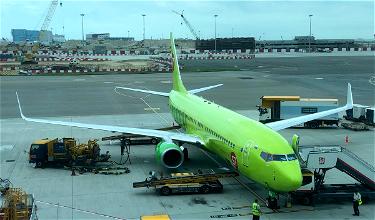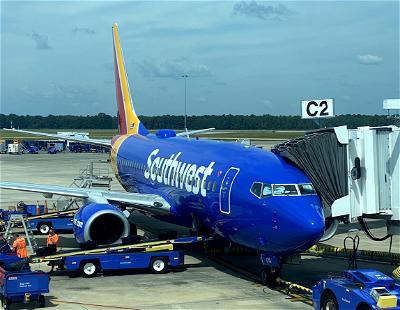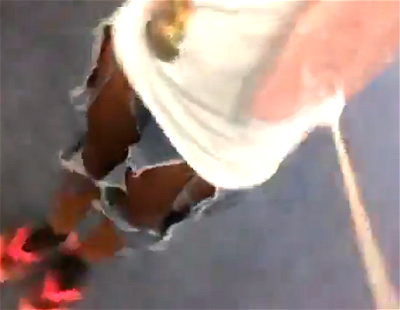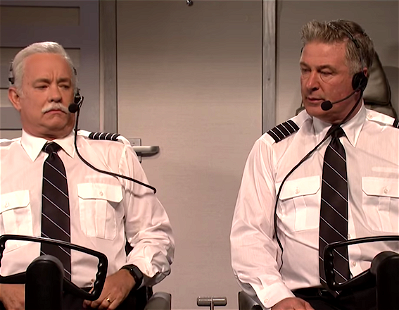On August 5, S7 Airlines (a oneworld member airline) had an incident while taking off from Moscow’s Domodedovo Airport to Simferopol. Flight S7263 was operated by a Boeing 737-800 with the registration code VQ-BKV.
The plane took off from runway 32L and flew all the way to Simferopol in a flight time of about 2hr10min.
A runway inspection of Moscow’s DME Airport then determined that there was glass debris and damaged lights at the end of the runway. At that point they reviewed the footage and figured out what happened. An inspection of the S7 737 was also carried out upon arrival, and revealed that three tires had been damaged, and that the landing gear had glass in it.
Here’s the video footage of this incident:
What’s crazy is that 32L isn’t a short runway — it’s 11,483 feet long, which is about double the length that a 737 requires under normal circumstances.
Obviously something went very wrong here, though even so, you’d think with 11,000+ feet this wouldn’t have come down to the last few feet of runway.
An investigation is being carried out into what happened, though AvHerald reports that this had to do with the takeoff weight being miscalculated, in one of two ways:
- The crew incorrectly computed the takeoff weight by 15 tons, which impacted the takeoff performance (the 737-800’s maximum takeoff weight is somewhere around 90 tons)
- The crew inadvertently entered the plane’s zero fuel weight instead of takeoff weight into the onboard computer (the plane can hold up to about 23 tons of fuel)
Suffice to say that this could have been catastrophic if they were any further off. For that matter, if there was any terrain or other obstacles nearby, it could have ended worse even under the same circumstances.
These kinds of situations are rare, though not totally unheard of.
For example, here’s video footage of a Royal Air Maroc 737 struggling to take off from Frankfurt Airport a couple of years back:
Then there’s the story of the Qatar Airways 777 that hit runway lights on takeoff while departing Miami Airport in 2015. This was determined to be due to the pilots taking off on the intersection of the runway, rather than using the full runway length (which is needed for a fully loaded 777). The plane flew all the way to Doha, though as it turned out the plane had a 46cm tear in the fuselage, as well as 90 dents and scratches.
While Qatar Airways’ CEO initially tried to write this off as something that happens all the time and isn’t a big deal, the pilots did end up getting fired.





Wow, scary video!
Thank you KJ. Good with proper input and not only “Oh my Goood!”.
Commercial Aircraft as a matter of course always use less than Full Power for take off,unless there are limiting factors that would require Full Power, this is to extend the service life of the engines.Among those factors would be Runway Length,Wet Runway,Obstacle clearance, Aircraft weight etc. Normally an airline puts as much weight as is possible onto an aircraft as possible for a given Runway,& this weight is determined by the most restrictive of Maximum...
Commercial Aircraft as a matter of course always use less than Full Power for take off,unless there are limiting factors that would require Full Power, this is to extend the service life of the engines.Among those factors would be Runway Length,Wet Runway,Obstacle clearance, Aircraft weight etc. Normally an airline puts as much weight as is possible onto an aircraft as possible for a given Runway,& this weight is determined by the most restrictive of Maximum Take off weight,Runway Length,Tyre speed etc.
I have not gone into too much detail,but hopefully people will get an idea of what goes on in the process. In addition,pilots as part of the Take off briefing to each other say,that " Up to 80 knots we stop for anything we don't like or any warning indications,between 80 knots & V1(Take off Decision Speed)
We will stop only for an Engine Failure,Engine Fire,Loss of directional Control ,or It is apparent that the aircraft will not fly"
Clearly this aircraft was not going to fly & so the takeoff should have been aborted alot sooner,so that the aircraft should have been no where neat the end of the runway. Assuming it used the Full length of the available runway 11000ft Lucky states,well the acceleration would have not been normal for them to be lifting off at the end of the runway,so the clues where there for the crew to abort,but hey,we weren't in the cockpit,so who really knows what was going on,but we are taking an educated guess,based on normal operations
Would be interesting to hear from a professional pilot - do they usually take off under less than full power on longer runways to minimize fuel burn/noise/engine wear? And if so, does that reduce safety margin for any takeoff weight calculation error?
You would think the flight computer would detect the actual acceleration is mismatched with the expected acceleration during the takeoff run and give the pilots some sort of error early in the process. It would be evident pretty quickly that something was off. Maybe the systems just don't monitor this sort of thing.
Interesting
Emirates ( EK407) Melbourne-Dubai: pilots made incorrect weight calculation ( by 100 tonnes) ran out of runway, tail strike on rotation, hit antenna, 500 metres past the end of the runway barely cleared perimeter fence. Miraculously able to climb away and dump fuel before returning. Classified as an accident rather than an incident.
Similar weight miscalculations have occurred on a number of airlines, including Air France.
Wow that Royal Air Maroc takeoff I have never seen a plane so close to rear of it dragging ok the runway. Looked vwry scary
Yeah, something was brewing “at that point” while those in biz class were reviewing the pre-departure champagne ...
that...is so close. Just 1/2 a second late would be catastrophic. Glad everyone is okay.
Whoever makes this kind of rudimentary mistake has to be fired, banned from flying for life, no innocents should die because someone punched a pad wrong and was too lazy to double check.